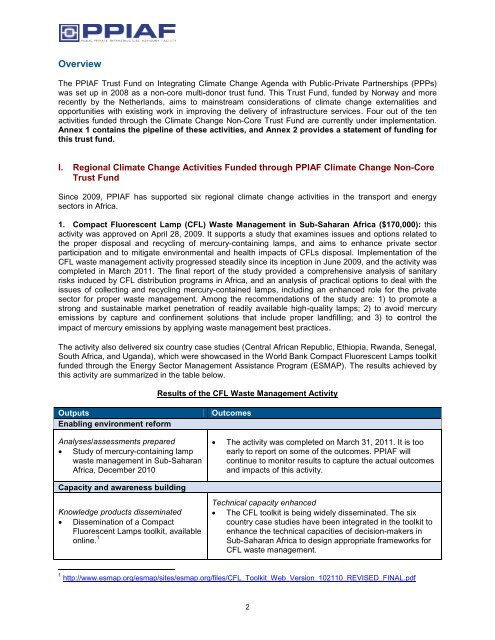PMR cover.psd - ppiaf
PMR cover.psd - ppiaf
PMR cover.psd - ppiaf
You also want an ePaper? Increase the reach of your titles
YUMPU automatically turns print PDFs into web optimized ePapers that Google loves.
Overview<br />
The PPIAF Trust Fund on Integrating Climate Change Agenda with Public-Private Partnerships (PPPs)<br />
was set up in 2008 as a non-core multi-donor trust fund. This Trust Fund, funded by Norway and more<br />
recently by the Netherlands, aims to mainstream considerations of climate change externalities and<br />
opportunities with existing work in improving the delivery of infrastructure services. Four out of the ten<br />
activities funded through the Climate Change Non-Core Trust Fund are currently under implementation.<br />
Annex 1 contains the pipeline of these activities, and Annex 2 provides a statement of funding for<br />
this trust fund.<br />
I. Regional Climate Change Activities Funded through PPIAF Climate Change Non-Core<br />
Trust Fund<br />
Since 2009, PPIAF has supported six regional climate change activities in the transport and energy<br />
sectors in Africa.<br />
1. Compact Fluorescent Lamp (CFL) Waste Management in Sub-Saharan Africa ($170,000): this<br />
activity was approved on April 28, 2009. It supports a study that examines issues and options related to<br />
the proper disposal and recycling of mercury-containing lamps, and aims to enhance private sector<br />
participation and to mitigate environmental and health impacts of CFLs disposal. Implementation of the<br />
CFL waste management activity progressed steadily since its inception in June 2009, and the activity was<br />
completed in March 2011. The final report of the study provided a comprehensive analysis of sanitary<br />
risks induced by CFL distribution programs in Africa, and an analysis of practical options to deal with the<br />
issues of collecting and recycling mercury-contained lamps, including an enhanced role for the private<br />
sector for proper waste management. Among the recommendations of the study are: 1) to promote a<br />
strong and sustainable market penetration of readily available high-quality lamps; 2) to avoid mercury<br />
emissions by capture and confinement solutions that include proper landfilling; and 3) to control the<br />
impact of mercury emissions by applying waste management best practices.<br />
The activity also delivered six country case studies (Central African Republic, Ethiopia, Rwanda, Senegal,<br />
South Africa, and Uganda), which were showcased in the World Bank Compact Fluorescent Lamps toolkit<br />
funded through the Energy Sector Management Assistance Program (ESMAP). The results achieved by<br />
this activity are summarized in the table below.<br />
Results of the CFL Waste Management Activity<br />
Outputs Outcomes<br />
Enabling environment reform<br />
Analyses/assessments prepared<br />
� Study of mercury-containing lamp<br />
waste management in Sub-Saharan<br />
Africa, December 2010<br />
Capacity and awareness building<br />
Knowledge products disseminated<br />
� Dissemination of a Compact<br />
Fluorescent Lamps toolkit, available<br />
online. 1<br />
� The activity was completed on March 31, 2011. It is too<br />
early to report on some of the outcomes. PPIAF will<br />
continue to monitor results to capture the actual outcomes<br />
and impacts of this activity.<br />
Technical capacity enhanced<br />
� The CFL toolkit is being widely disseminated. The six<br />
country case studies have been integrated in the toolkit to<br />
enhance the technical capacities of decision-makers in<br />
Sub-Saharan Africa to design appropriate frameworks for<br />
CFL waste management.<br />
1 http://www.esmap.org/esmap/sites/esmap.org/files/CFL_Toolkit_Web_Version_102110_REVISED_FINAL.pdf<br />
2

















